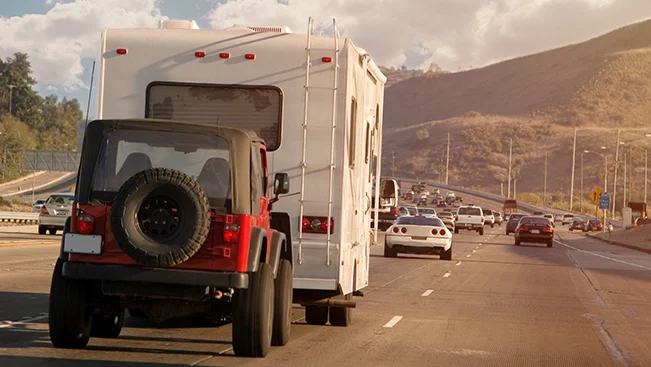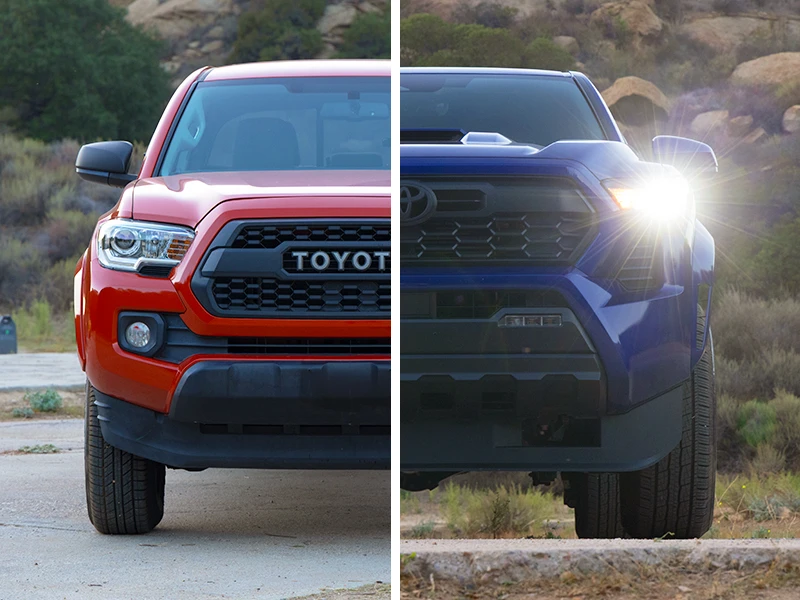The basics of flat towing your car, truck or SUV behind your RV.

With thousands of vehicles in our inventory, we’re here to help make car research easier for you. We’ve partnered with car-review experts from Edmunds to weigh in on what matters most, whether you’re looking to buy or sell a car.
***
Motorhomes can be a pleasant way to travel, letting you stay at a campsite, alongside a picturesque stream, or even on the street at Aunt Matilda's for the annual family get-together.
But things change when you need to run into town for groceries or want to take a sightseeing trip after you've set up camp. Driving that beast along narrow and twisty roads, navigating urban traffic, trying to find parking, and paying for the additional fuel it's consuming can be anything but pleasant.
With a small car or truck available, however, motorhome travelers don't have to stow all their gear and pull up stakes every time they want to go somewhere. That's why it is not uncommon to see big RVs pulling smaller vehicles behind them. That extra set of wheels, often in the form of a little SUV or subcompact car, makes it so much easier to get around. This kind of practical addition delivers the dimensions, horsepower, and torque capabilities better suited to big errands and even bigger adventures.
Trailering Is Not Best
With two-wheeled dollies and four-wheeled trailers, almost any vehicle can be towed behind an RV, provided that the weight of the car or truck and whatever is being used to facilitate the tow doesn't exceed the motorhome's recommended towing capacity. But that kind of towing isn't all that popular, for good reason.
First, there's the expense of buying and maintaining a trailer or tow dolly. Then there's the storage space at home and at the campsite that those conveyances require when not in use, as well as the extra work needed to get the towed vehicle on and off the trailer.
The Dinghy's the Thing
The alternative is flat towing, also called "four-down towing" or "dinghy towing." It involves attaching a tow bar to a suitable car, SUV or pickup and letting the vehicle roll along behind the motorhome on its own four tires (thus "four-down" towing). It's often called dinghy towing because the towed vehicle resembles a small dinghy being pulled behind a large yacht at sea.
Before you even think about flat-towing though, it's important to check the owner's manual for your vehicle. It's also important to check the vehicle's warranty and any optional extended service plan you may have purchased. Sometimes, towing the vehicle incorrectly or using aftermarket accessories can void your warranty or service plan.
Years ago, finding cars suitable for flat towing wasn't all that hard. Most cars and trucks with manual transmissions could be pulled four-down. So could most four-wheel-drive SUVs with manual transfer cases. But things change. Today, with the abundance of advanced onboard tech, electronic transmissions and front-wheel-drive and full- and part-time four-wheel-drive systems, it requires a bit of planning when you are selecting cars and trucks to flat tow.
Transmission Trouble
Toyota, for instance, makes several vehicles that would seem ideal for flat towing. For hearty off-road adventurers, there are the Land Cruiser and the 4Runner. And while they're fine on their own on rough terrain, the company's four-wheel-drive trucks don't make the grade when it comes to flat towing. The vast majority of automatic-transmission vehicles from Toyota, Lexus and the discontinued Scion brand don't qualify for dinghy towing.
It all has to do with transmission lubrication, according to Toyota. Some Toyota vehicles require continuous operation of a pump inside the transmission to keep the moving parts lubricated, and those cars can't be towed four-down. With automatic transmissions and pump-dependent manuals, the output shaft isn't being lubricated unless the vehicle's engine is running, and a car can suffer severe transmission damage if it is towed with the driven wheels rolling along the highway, turning the driveshaft or, in the case of front-wheel-drive cars, the half-shafts.
So What Can You Tow?
Typically, a vehicle can be pulled dinghy-style if it has rear-wheel drive and a manual transmission or four-wheel drive and a manual transfer case that can be placed in neutral. The best way to make sure a vehicle is suited to flat towing is to check the owner's manual. You should also ensure any vehicle software is fully up to date. Virtually every automaker states clearly in every model's manual whether it can be towed on all four wheels or whether it must be hauled on a flatbed truck or trailer or pulled "two-down" with the driven wheels (the front wheels in a FWD car, the rear in a RWD one) off the ground.
For a quick overview, MotorHome magazine (MotorHome.com) publishes annual lists of dinghy-towable vehicles. They are available for download at no cost, dating back to the 2000 model year.
Aftermarket Add-Ons
If your vehicle isn't suitable for flat towing, there are devices, including driveshaft decouplers and transmission lubrication pumps, that can be added to some automatic-transmission vehicles to handle the job. The devices can be expensive and complicated to install and maintain, though, and sometimes their installation can have a negative impact on your warranty or any optional extended service plan you may have purchased. And if they're not used correctly, the engine or drivetrain components can be damaged while a vehicle is being towed.
If you are looking for a towable vehicle, it's best to concentrate on those that are factory-ready.
How to Narrow the Field
To keep from looking through hundreds of owner's manuals for details on tow readiness, thin the list of candidates by deciding what kind of towed vehicle will best suit your needs: a 4x4 if you like to go off-roading, for instance, , or a pickup for sports and hobby equipment. Then decide what you can afford to spend.
Other Flat-Towing Tricks
While dinghy towing makes things easier once you've arrived at your destination, it can add work before and during the journey.
Some cars and SUVs that can be towed four-down require special stops to run the engine in order to lubricate the transmission. Some require removal of various fuses before starting off. There are a number of four-wheel-drive trucks with automatic transmissions that must be towed four-down with their transmissions in the park position and their transfer cases in neutral.
Vehicles with steering locks triggered by the ignition - and that's most of them these days - can't be flat towed if the front wheels won't turn. The key must be in the ignition and the ignition switched to the accessory position in order to unlock the steering.
Don't assume that because previous model years were towable, this year's will be as well. For example, the second-generation Ford Escape was a popular dinghy-tow vehicle with the RV crowd. But after its 2013 redesign, it was no longer certified to be pulled with all four wheels on the ground.
Finally, most states require most vehicles being flat towed to be equipped with auxiliary brake systems that work in tandem with the motorhome's brakes. That's because flat-towed vehicles almost always exceed various states' minimum towing weight requirements. Smart motorhome owners who tow a car or truck know that even in those states that don't require them, auxiliary brake kits should be considered essential.
Check the Manual, Then Check Again
Once you think you've found a vehicle that will suit you, the best next step is to get an owner's manual. You can often find them online.
Everything you'll need to know about pulling the car or truck dinghy-style will be in the manual, including detailed instructions on which fuses to pull (if any), the proper position for the transmission shift lever, which switches to leave on and which to turn off, and how often to run the engine for lubrication. Being armed with this information will save you time and money, and help you get to your destination with your flat-tow vehicle and your RV in good shape.




